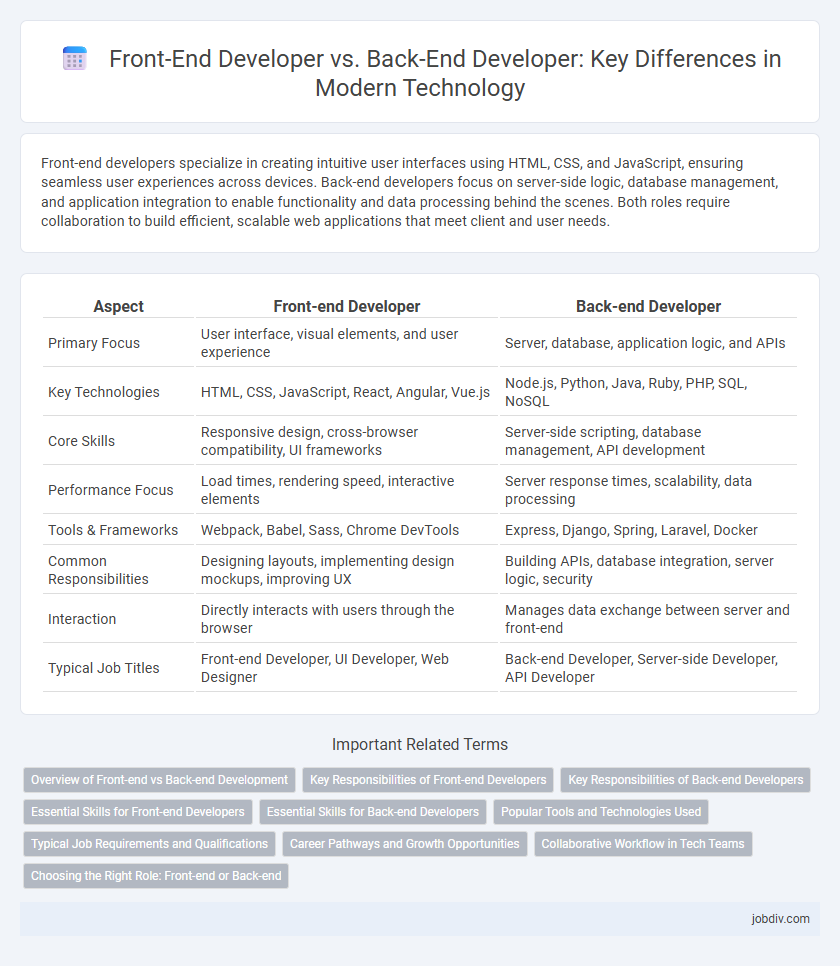Front-end developers specialize in creating intuitive user interfaces using HTML, CSS, and JavaScript, ensuring seamless user experiences across devices. Back-end developers focus on server-side logic, database management, and application integration to enable functionality and data processing behind the scenes. Both roles require collaboration to build efficient, scalable web applications that meet client and user needs.
Table of Comparison
| Aspect | Front-end Developer | Back-end Developer |
|---|---|---|
| Primary Focus | User interface, visual elements, and user experience | Server, database, application logic, and APIs |
| Key Technologies | HTML, CSS, JavaScript, React, Angular, Vue.js | Node.js, Python, Java, Ruby, PHP, SQL, NoSQL |
| Core Skills | Responsive design, cross-browser compatibility, UI frameworks | Server-side scripting, database management, API development |
| Performance Focus | Load times, rendering speed, interactive elements | Server response times, scalability, data processing |
| Tools & Frameworks | Webpack, Babel, Sass, Chrome DevTools | Express, Django, Spring, Laravel, Docker |
| Common Responsibilities | Designing layouts, implementing design mockups, improving UX | Building APIs, database integration, server logic, security |
| Interaction | Directly interacts with users through the browser | Manages data exchange between server and front-end |
| Typical Job Titles | Front-end Developer, UI Developer, Web Designer | Back-end Developer, Server-side Developer, API Developer |
Overview of Front-end vs Back-end Development
Front-end development centers on creating user interfaces and experiences using HTML, CSS, and JavaScript, ensuring responsive design and seamless interaction across devices. Back-end development involves server-side logic, databases, and application integration through languages like Python, Java, or Node.js to manage data flow and security. Together, these roles collaborate to build functional, scalable web applications that deliver robust performance and intuitive user engagement.
Key Responsibilities of Front-end Developers
Front-end developers specialize in creating intuitive user interfaces using HTML, CSS, and JavaScript, ensuring seamless interaction and responsive design across multiple devices. They optimize website performance and accessibility by implementing efficient code and adhering to web standards. Their key responsibilities also include integrating APIs and collaborating with UI/UX designers to deliver engaging digital experiences.
Key Responsibilities of Back-end Developers
Back-end developers focus on server-side logic, database management, and application integration to ensure seamless functionality behind user interfaces. They write APIs, handle authentication, and optimize server performance to support front-end operations. Their key responsibilities include managing data storage, ensuring security protocols, and maintaining scalable, efficient server infrastructure.
Essential Skills for Front-end Developers
Front-end developers must master HTML, CSS, and JavaScript to create responsive and user-friendly interfaces. Proficiency in frameworks like React, Angular, or Vue.js is essential for building dynamic web applications and enhancing user experience. Strong skills in UX/UI design principles and version control systems such as Git further empower front-end developers to deliver efficient and maintainable code.
Essential Skills for Back-end Developers
Back-end developers must master server-side programming languages such as Python, Java, Ruby, and PHP to create robust APIs and manage database interactions effectively. Proficiency in database technologies like MySQL, PostgreSQL, and MongoDB ensures efficient data storage and retrieval. Knowledge of version control systems, server management, and security protocols is crucial for maintaining scalable and secure web applications.
Popular Tools and Technologies Used
Front-end developers commonly use tools like React, Angular, and Vue.js for building dynamic user interfaces, alongside HTML, CSS, and JavaScript frameworks that enhance user experience. Back-end developers rely on technologies such as Node.js, Django, Ruby on Rails, and databases like MySQL, MongoDB, or PostgreSQL to manage server-side operations and data storage. Both roles often utilize version control systems like Git and development environments such as Visual Studio Code to streamline collaboration and coding efficiency.
Typical Job Requirements and Qualifications
Front-end developers typically require proficiency in HTML, CSS, JavaScript, and frameworks like React or Angular to create responsive and user-friendly interfaces. Back-end developers need expertise in server-side languages such as Python, Java, or Node.js, alongside database management skills using SQL or NoSQL. Both roles demand strong problem-solving abilities, knowledge of version control systems like Git, and experience with RESTful APIs for seamless integration.
Career Pathways and Growth Opportunities
Front-end developers specialize in user interface design and client-side scripting, mastering frameworks like React and Angular, which opens pathways to roles such as UX/UI designer or front-end architect. Back-end developers work with server-side languages like Python, Java, and databases, enabling progression into positions like DevOps engineer or software architect. Both career paths offer growth through continuous skill enhancement and the increasing demand for full-stack development expertise.
Collaborative Workflow in Tech Teams
Front-end developers specialize in creating user interfaces using HTML, CSS, and JavaScript, ensuring seamless user experiences. Back-end developers manage server-side logic, databases, and APIs to support application functionality and data integrity. Effective collaboration between front-end and back-end developers relies on clear communication, shared version control systems like Git, and well-defined API contracts to streamline development and deployment processes.
Choosing the Right Role: Front-end or Back-end
Choosing the right role between front-end and back-end developer depends on your interest in either user interface design or server-side logic. Front-end developers specialize in HTML, CSS, and JavaScript to create responsive, user-friendly websites, while back-end developers work with databases, server scripting, and APIs using languages like Python, Java, or Ruby. Assessing your strengths in design aesthetics or problem-solving with data management can help guide the decision toward either front-end or back-end development careers.
Front-end Developer vs Back-end Developer Infographic

 jobdiv.com
jobdiv.com